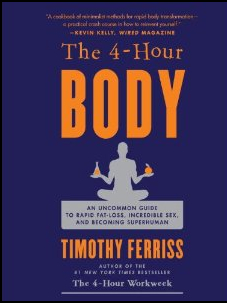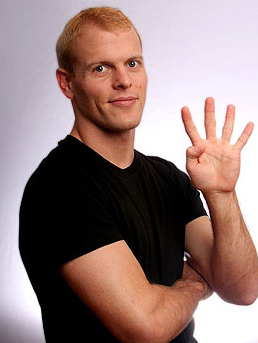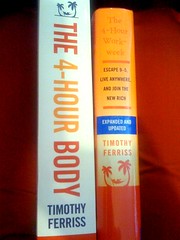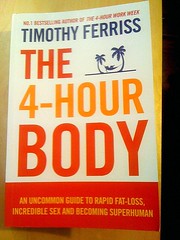OLD POST ALERT! This is an older post and although you might find some useful tips, any technical or publishing information is likely to be out of date. Please click on Start Here on the menu bar above to find links to my most useful articles, videos and podcast. Thanks and happy writing! – Joanna Penn
 You may have heard about Tim Ferriss' new book ‘The Four Hour Body: An uncommon guide to rapid fat-loss, incredible sex and becoming superhuman” (4HB). The book made it to #1 on the NY Times Bestseller list for Christmas and will no doubt remain there for sometime.
You may have heard about Tim Ferriss' new book ‘The Four Hour Body: An uncommon guide to rapid fat-loss, incredible sex and becoming superhuman” (4HB). The book made it to #1 on the NY Times Bestseller list for Christmas and will no doubt remain there for sometime.
Tim did this previously with ‘The Four Hour Workweek” (4HWW) which has remained on the business charts for the last 3 years, after initially being rejected by 26 out of 27 publishers.
From a personal perspective, I am an avid fan of Tim's blog and have been waiting for 4HB since October when I pre-ordered it on Amazon.com. It still hadn't arrived in Australia by New Year so I went and bought another copy anyway, as I was so desperate to read it. I spent New Year's Day engrossed, making notes and now I'm on the slow carb diet (like many others!). I highly recommend the book if you're interested in physical transformation.
From an author perspective, there's a great deal we can learn from how Tim turned me (and millions of others) into raving fans using incredible marketing techniques as well as fantastic content.
Here are some lessons authors can learn from Tim's two book launches:
- Develop a personal brand based on delivery of valuable quality information. Tim's blog is awesome. It's one of my must-reads and although he's not a prolific blogger, each post is thought-provoking and often actionable. His posts vary on aspects of lifestyle design, some are short videos and others are essay length articles. I would not have bought this book without the credibility that Tim brings to the content, much of which he has tested on his blog for popularity of content. Examples: From Geek to Freak, How to lose 20lb of fat in 30 days with no exercise.
- Build relationships with targeted bloggers. Tim was unknown before the amazing success of 4HWW and primarily used blogs for his original launch based on soft selling through relationships. He had originally hired a PR firm for $18,000 and had zero results from traditional media so decided to go and meet top bloggers in person at conferences throughout the US. Tim focused on tech blogs specifically and got to know thought leaders and influencers. He didn't hard sell either, approaching from a learning perspective or using his hobbies and experiences to find a shared common ground. For more detail: How to create a global phenomenon for less than $10,000
- Start awareness of the book early to build anticipation. Tim has been blogging on health related topics for years now, but he announced the book cover and title in this post in September, well ahead of the December launch. It contained the launch date and information on how to pre-order and also how to get involved in the launch. He also solicited input for videos and advertising ideas from the blog audience.
- Be incredibly organized. Tim acknowledges his OCD tendencies which you can find in the incredible detail of the book, but we all need to have some level of obsessive control over our launch process. In this article, Tim explains how he used collaborative software Basecamp and Highrise to manage the book creation with an assistant as well as the launch. If you're preparing interviews, guest articles, blog posts and more, you need to prepare in advance.
![Tim Ferriss Books]() Run competitions with great prizes. Tim had a big budget (or many sponsors) so his prizes were out of this world crazy to encourage sales. It was perhaps more incentivising than a true competition as you were guaranteed bonus material if you even bought one book, but you could also buy 10,000 copies and join Tim on a transatlantic crossing (wow!)
Run competitions with great prizes. Tim had a big budget (or many sponsors) so his prizes were out of this world crazy to encourage sales. It was perhaps more incentivising than a true competition as you were guaranteed bonus material if you even bought one book, but you could also buy 10,000 copies and join Tim on a transatlantic crossing (wow!)
- Test, gather data, test. Tim tested the book title for ‘4 Hour Work Week' using Facebook advertising and found the headline converted the most traffic. He has used the same 4 hour tag-line for 4HB indicating a now established brand, but with the subtitle for 4HB he also used crowd-sourcing to determine the highest converting term. Tim has also been a detailed data guy for years, measuring everything he does. The book is filled with data and although most of us will never be that diligent with measurement, it certainly pays to test book titles and other aspects. I tested various options for my book cover based on Tim's example and was completely surprised by the final result. Remember: you are not your audience!
- Ask for people to buy the book and support the launch. In this post where Tim announced the book title and cover, he also asked for pre-orders. Marketers will know that you need a call to action when you are trying to sell, so don't forget to ask. The law of reciprocation also kicks in when a reader has been consuming quality information for free for months or years. Most people are not going to mind spending some money on the book even if it's just out of loyalty.
- Target a specific release day. It's unknown exactly how many books you need to sell to hit the Amazon, NY Times and other lists on any given day, but it is clear that you need to sell a large number in a short period of time. This is the idea behind the Amazon bestseller campaigns which you may have heard about or seen advertised. You can do this yourself if you have built up a list of supporters and fans as also demonstrated recently by Machine of Death, an indie anthology.
![Four Hour Work week book cover in Australia]()
Australian cover Four Hour Work Week
- Your book is not interesting, the story around the book is. Polarizing can be an effective marketing technique. The sex aspects of the book have meant that Tim could not garner mainstream TV and radio interviews for 4HB in the US, despite the useful information that would help millions of relationships. But let's face it, the sub-title may have also gained him sales as people are interested in reading that type of information! So, it was a double-edged sword and I'm sure, a well considered one. Previously for the 4HWW Tim focused more on stories of his travels and exploits, and actionable tips for people on lifestyle design which made him an interesting interview subject.
-
- Use multi-media. Book trailers are growing as a way to market as video search becomes increasingly popular. Check out the 4HB trailer below which is definitely geared towards a specific group of people. Tim has also done audio and video interviews for the launch in the same way that Seth Godin did for his web 2.0 media launch.
- Write an excellent book. Tim has been gathering data from his own body experiments for years and in the book he shares information on the cutting edge of what the human body can do. I'm on my second reading so far, because let's face it, most writers don't read much about fitness and often suffer from desk-bound weight, posture and health issues. It is an excellent book, although not everything applies to everyone. Tim calls it a ‘choose your own adventure' guide. It certainly delivers on a promise, and also continues in the vein of 4HWW which I still read annually. Excellent marketing is one thing, but word of mouth after release keeps the book selling for years and that depends on the quality of the book.
Clearly, some of these steps can be implemented quickly but most take the long view, where content, relationships and presence are built up over time to create a successful launch.
Which of these will you be implementing for your next launch? Please leave a comment with your thoughts below.
The post The Four Hour Body: Lessons Learned From Tim Ferriss’ Book Launch first appeared on The Creative Penn.

 Run competitions with great prizes. Tim had a big budget (or many sponsors) so
Run competitions with great prizes. Tim had a big budget (or many sponsors) so 